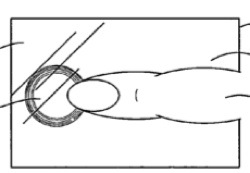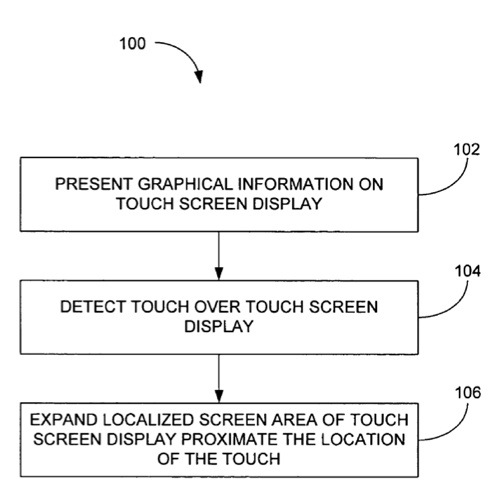An Apple patent (number 7,760,187) for a visual expander has appeared at the US Patent & Trademark Office. It seems to concern an upcoming feature for the iOS -- and perhaps Mac OS X.
A computer implemented method for a touchscreen display is disclosed. The method includes presenting graphical information on the touchscreen display. The method further includes detecting a touch over the touchscreen display. The method also includes expanding an area of the touch screen display proximate the location of the touch. The inventor is Peter Kennedy.
Here's Apple's background and summary of the invention: "There exist today many styles of input devices for performing operations in a computer system. The operations generally correspond to moving a cursor and/or making selections on a display screen. By way of example, the input devices may include buttons or keys, mice, trackballs, touch pads, joy sticks, touch screens and the like. Each of these devices has advantages and disadvantages that are taken into account when designing or configuring a computer system.
"Touch screens, in particular, are becoming increasingly popular because of their ease and versatility of operation as well as to their declining price. Touch screens allow a user to make selections and move a cursor by simply touching the display screen via a finger or stylus. For example, a user may make a selection by pointing directly to a graphical object displayed on the display screen. The graphical object may for example correspond to an on-screen button for performing specific actions in the computer system.
"In general, the touch screen recognizes the touch and position of the touch on the display screen and the computer system interprets the touch and thereafter performs an action based on the touch event. There are several types of touch screen technologies including resistive, capacitive, infrared and surface acoustic wave.
"While touchscreens generally work well, they are difficult to use when features such as buttons, web page links, or UI controls presented on the touch screen display are too small for finger activation, i.e., the finger is too large relative to the button, link or UI controls. Even if these features could be enlarged to meet minimum human factors requirements, they would adversely reduce the amount of space available for displaying other information to the user. In fact, in most cases the features are made small due to the limited amount of screen space (especially in handheld devices).
"Furthermore, the features typically do not provide the user with any feedback indicating that a finger is located on the feature. This may make it difficult to determine what feature is being selected. As a result, the user may incorrectly select a feature. Moreover, once the size of the features are set, they typically cannot be changed. For example, in web browsing users have no control over the size of the link or button presented by a website.
"In most small touchscreens such as those used in personal digital assistants, styli are used to help pin point areas for selection and to perform gestures such as those used to enter characters or symbols. While this generally provides a solution to activating small features, the styli has its own drawbacks. For example, the user still has to manipulate the stylus over the feature. This may be difficult for some users such as those who are visually impaired or those with limited coordination. In addition, the stylus can be lost and it can be aesthetically unpleasing.
"For example, the stylus is typically separate from the computing device in which it is used and therefore the stylus can be easily misplaced by the user. With regards to being aesthetically unpleasing, the computing device typically includes a receptacle, which receives the stylus and which produces unwanted breaks and cracks in the external surface of the computing device. Moreover, the stylus is less intuitive than using a finger.
"Recently, several software products have come on the market that help visually impaired individuals see objects displayed on the screen. These software products are typically implemented in traditional computer systems such as those that include a desktop and a CRT monitor. The software products typically include magnifiers that magnify a portion of the screen.
"The magnifiers may for example be implemented with a virtual magnifying glass. The virtual magnifying glass magnifies the GUI in the area of the magnifying glass, i.e. similarly to moving a magnifying glass over a printed piece of paper. The magnifying glass allows the user to traverse through the GUI so that the user can read small text.
"In most cases, the virtual magnifying glass is controlled by moving a cursor such as for example via a remote mouse, or trackball. While virtual magnifying glasses work well, they are limited. For example, they typically do not allow features to be manipulated or selected inside the magnified area. Furthermore, they may not allow text editing therein.
"Some operating systems such as Apple Computer's OS-X are designed to magnify a dock including the icons contained therein when the cursor is moved over the docks icons. While this works well, the feature has no control over the content presented on the remainder of the screen, i.e., the remaining portions of the screen do not magnify when the cursor is positioned thereover. Furthermore, this particular feature only works on the main system page. It does not work in programs or applications or even web pages.
"The invention relates, in one embodiment, to a computer implemented method for a touchscreen display. The method includes presenting graphical information on the touchscreen display. The method further includes detecting a touch over the touchscreen display. The method also includes expanding an area of the touch screen display proximate the location of the touch.
"The invention relates, in another embodiment, to a computer implemented method. The method includes presenting a graphical user interface (GUI). the method also includes sensing an object over the graphical user interface. The method further includes visually expanding an area of GUI near the sensed object. The method additionally includes if the expanded area includes a selectable feature, performing an action associated with the feature when the feature is selected.
"The method further includes if the sensed object is moving over the GUI, moving the expanded area in accordance with the moving object. Moreover, the method includes if the object is no longer sensed, maintaining the expansion of the expanded area in the last sensed location for a predetermined amount of time.
"The invention relates, in another embodiment, to a computer implemented method. The method includes displaying graphical information. The method also includes detecting an object over the graphical information. The method further includes visually expanding portions of the graphical information in close proximity and underneath the detected object."














